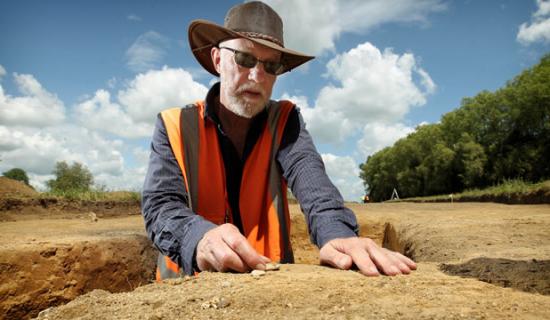'Each site has got its bit to say'
Aaron Leaman
Source - http://www.stuff.co.nz/waikato-times/news/7992092/Pits-reveal-glimpses-of-past

CFG Heritage archaeologist Dr Matthew Campbell examines an ancient kumara storage pit. Bottom: Flakes of obsidian. - BRUCE MERCER/Fairfax NZ
An evacuation of centuries-old borrow pits near Cambridge is giving archaeologists a unique glimpse into the lives of pre-European Maori.
An archaeological team this week began excavating farmland off Swayne Rd, along the designated route of the Cambridge section of the Waikato Expressway. Construction of the section is expected to start late next year.
So far, the team has unearthed three kumara storage pits, 10 fire scoops and seven borrow pits - all estimated to be between 300-400 years old.
A borrow pit is where Maori removed gravel or sand for mixing with soil elsewhere to create good growing medium for their crops.
Excavation director Dr Matthew Campbell said the findings added to people's understanding of pre-European Maori.
"So far there's been no surprises but each site is unique and adds to our understanding of our past. It's the continuation of our story and each site has got its bit to say."
Archaeologists have also unearthed about 15 flakes of obsidian, or volcanic glass, originating from Mayor Island in the Bay of Plenty.
Dr Campbell said Mayor Island obsidian was prized by Maori who used its sharp edges for cutting.
"It was high quality and would have been brought here, perhaps to sharpen wooden tools or work flax. It was like a prehistoric pocket knife."
Mayor Island obsidian has been found all over the North Island.
Samples of charcoal taken from fire scoops would also be analysed to determine what trees species originally grew in the area.
Dr Campbell said as Maori moved inland from the coast, they became more reliant on kumara and developed specialised techniques to grow it.
Opus archaeologist Beatrice Hudson said such sites were finite historical resources "and once they're gone, they're gone".
"This is about taking the information that is in the ground and putting that information in reports for museums and for the public."